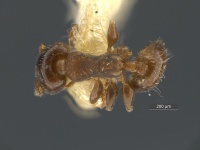Xenomyrmex panamanus
| Xenomyrmex panamanus | |
|---|---|

| |
| Scientific classification | |
| Kingdom: | Animalia |
| Phylum: | Arthropoda |
| Class: | Insecta |
| Order: | Hymenoptera |
| Family: | Formicidae |
| Subfamily: | Myrmicinae |
| Tribe: | Crematogastrini |
| Genus: | Xenomyrmex |
| Species: | X. panamanus |
| Binomial name | |
| Xenomyrmex panamanus (Wheeler, W.M., 1922) | |
This species, and genus, are not commonly collected.
Identification
Longino (Ants of Costa Rica) - Color dark brown; pronotal dorsum densely punctate, clypeus with pair of strong longitudinal carinae, middle and hind tibiae usually with one or more erect setae in addition to appressed pubescence.
Distribution
Latitudinal Distribution Pattern
Latitudinal Range: 19.59944444° to 9.156944444°.
| North Temperate |
North Subtropical |
Tropical | South Subtropical |
South Temperate |
- Source: AntMaps
Distribution based on Regional Taxon Lists
Neotropical Region: Costa Rica, Panama (type locality).
Distribution based on AntMaps
Distribution based on AntWeb specimens
Check data from AntWeb
Countries Occupied
| Number of countries occupied by this species based on AntWiki Regional Taxon Lists. In general, fewer countries occupied indicates a narrower range, while more countries indicates a more widespread species. |

|
Estimated Abundance
| Relative abundance based on number of AntMaps records per species (this species within the purple bar). Fewer records (to the left) indicates a less abundant/encountered species while more records (to the right) indicates more abundant/encountered species. |

|
Biology
Longino (Ants of Costa Rica) - I know of two collections of this species from Costa Rica. The first was a collection I made in Corcovado National Park. I was in the canopy of a large Licania tree (Chrysobalanaceae). I found the workers sparsely distributed in tiny, connected chambers below and sometimes actually in flat, securely attached bark. The bark was on a 10cm diameter epiphyteless branch. One chamber covered two pink Coccoidea. The workers were very difficult to collect. When I pried a piece of bark loose, the one or two exposed ants ran immediately to crevices or tunnels no wider than the ants. I never found a chamber with brood or more than 3 adults.
The second collection was from La Selva Biological Station, where workers were obtained in one of the Project ALAS canopy fogging samples. The species occurred in only one of nearly 50 separately fogged tree crowns and has never been collected by other methods, so it is rare and/or difficult to sample by traditional methods.
Wheeler (1931) - The two specimens from which this species was described were found at Colon, Panama. More recently I have taken several specimens at Mt. Hope and on Barro Colorado Island, in the same region, always running singly on tree-trunks. I was unable to find the nests, which are probably excavated in the bark or twigs.
Castes
   
| |
| . | |
Nomenclature
The following information is derived from Barry Bolton's Online Catalogue of the Ants of the World.
- panamanus. Myrmecinella panamana Wheeler, W.M. 1922d: 1, fig. 1 (w.) PANAMA. Combination in Xenomyrmex: Wheeler, W.M. 1931a: 133.
Description
References
- Wheeler, W. M. 1922f. A new genus and subgenus of Myrmicinae from tropical America. American Museum Novitates 46: 1-6 (page 1, fig. 1 worker described)
- Wheeler, W. M. 1931a. Neotropical ants of the genus Xenomyrmex Forel. Rev. Entomol. (Rio J.) 1: 129-139 (page 133, Combination in Xenomyrmex)
References based on Global Ant Biodiversity Informatics
- Adams B. J., S. A. Schnitzer, and S. P. Yanoviak. 2016. Trees as islands: canopy ant species richness increases with the size of liana-free trees in a Neotropical forest. Ecography doi: 10.1111/ecog.02608
- Adams B. J., S. A. Schnitzer, and S. P. Yanoviak. 2019. Connectivity explains local ant community structure in a Neotropical forest canopy: a large-scale experimental approach. Ecology 100(6): e02673.
- Creighton W. S. 1957. A study of the genus Xenomyrmex (Hymenoptera, Formicidae). American Museum Novitates 1843: 1-14.
- Dattilo W. et al. 2019. MEXICO ANTS: incidence and abundance along the Nearctic-Neotropical interface. Ecology https://doi.org/10.1002/ecy.2944
- Ettershank G. 1966. A generic revision of the world Myrmicinae related to Solenopsis and Pheidologeton (Hymenoptera: Formicidae). Aust. J. Zool. 14: 73-171.
- Fernández, F. and S. Sendoya. 2004. Lista de las hormigas neotropicales. Biota Colombiana Volume 5, Number 1.
- García-Martínez M. A., J. E. Valenzuela-González , D. L. Martínez-Tlapa , and L. N. Quiroz-Robledo. 2013. New Ant Species (Hymenoptera: Formicidae) Records for Veracruz State and Mexico. Southwestern Entomologist 38(4): 661-666.
- Kempf, W.W. 1972. Catalago abreviado das formigas da regiao Neotropical (Hym. Formicidae) Studia Entomologica 15(1-4).
- Longino J. T., and R. K. Colwell. 2011. Density compensation, species composition, and richness of ants on a neotropical elevational gradient. Ecosphere 2(3): 16pp.
- Wheeler W. M. 1922. A new genus and subgenus of Myrmicinae from tropical America. American Museum Novitates 46: 1-6.
- Wheeler W. M. 1931. Neotropical ants of the genus Xenomyrmex Forel. Revista de Entomologia (Rio de Janeiro) 1: 129-139.

